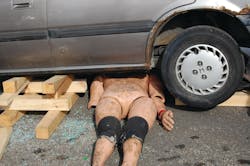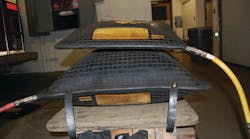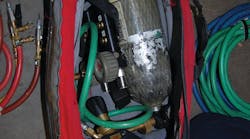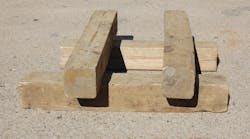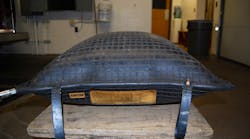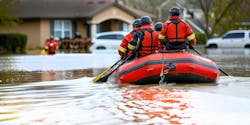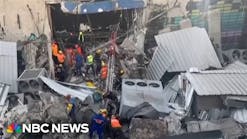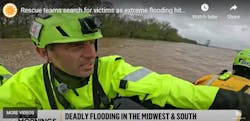The past series of articles discussed everything leading up to the actual air-bag lift. This article will focus on the lift itself. The lift must be carefully orchestrated to ensure it is performed safely and efficiently. Members must confirm they have gathered all of the essential equipment and each member’s role has been clearly assigned.
Essential Equipment
As reviewed in previous articles, all of the critical extrication equipment should be brought to the lift site. Members must verify that the air-bag system is fully assembled and any additional bags, hoses, shutoffs and air supplies are readily accessible. Members must also evaluate the amount of cribbing on hand to confirm that there is enough staged to crib the height of the load during the rescue operation and to further support the load after it is lifted.
Members should have the necessary EMS equipment ready for treating a severely injured patient and for safely removing the patient from the lift site. Equipment considerations are EMS bags, splints, C-collars, backboards and Stokes baskets.
Critical Roles
As with any incident there should be a clearly defined incident command structure. There are a few roles at an air-bag operation that are similar to those at a fire incident, such as the incident commander and the safety officer. In addition to the standard incident command roles, there are many specialty roles that are vital to the success of the operation.
The incident commander (IC) is in charge of the overall operation. The IC should ensure that the appropriate resources are on scene, and crews are being assigned and managed appropriately.
The safety officer at an air-bag operation should focus on the “big picture” of the incident. The safety officer should evaluate the placement of equipment and confirm that all hazards are mitigated prior to the start of the operation. The safety officer should be in a position that offers an unobstructed view of the load that is being lifted. Once lifting operations have commenced, the safety officer monitors the conditions and activities to watch for any shifting of the load, to make sure the load is being cribbed appropriately and to assure members are not unnecessarily being placed in the hazard zone. Any perceived safety concerns or requirements are reported directly to the IC.
A medical officer should be assigned to supervise the medical aspect of the operation. The medical officer or their designee should be near the patient to assess his/her status and injuries. If the victim has crush injuries, it may be necessary to start treatment prior to the completion of the extrication process. The medical officer might end up providing stabilization to the affected body part during the lift operation. The medical officer should verify that appropriate EMS equipment and personnel are ready for victim removal. It is also essential that the medical officer confirm that an ambulance or helicopter is on scene and ready for patient transport.
The lift officer is in charge of the actual lifting operation and gives the command to inflate the air bags. It is critical to have only one person giving commands for the lift to avoid confusion from conflicting orders. The lift officer should be close to the victim and monitor the amount of lift needed to free the victim. If scene conditions do not allow the lift officer to be right with the victim, there should be voice contact with the medical officer who is with the patient.
The control person carries out the orders of the lift officer and runs the air-bag controls upon those orders. The control person should be positioned as far back from the immediate hazard zone as possible, but close enough to be in voice contact with the lift officer (Photo 1). The control person should monitor the pressure in the bags to confirm that the bottom bag is inflated to a lesser percentage than the top bag. This lower inflation allows the bags to be more stable by having the harder upper bag nest into the softer lower bag.
Finally, numerous support personnel are required for the operation to run smoothly. A sufficient number of personnel are needed to ensure that the load is being effectively cribbed as it is lifted (Photo 2). This may require having members placed at various spots around the load. Support personnel should stand by at the ready and be available for the actual removal of the victim under the direction of the medical officer. It is also recommended to have members staged by the apparatus to retrieve any additional equipment needed for the operation.
The Lift
Once the system is assembled and the appropriate personnel are in place, the lift operation can commence. The lift officer must verify that all members are ready for the lift. All members should be on “high alert” during the lift operation and watch for any shifting of the load.
The lift officer will begin the operation by ordering the lower air bag to be inflated slowly by calling “up on (color of hose attached to lower bag).” The bag should be inflated slowly to minimize the chance of the load shifting. Once the bag is inflated sufficiently, the lift officer will call “stop.” The lift officer should allow time for the members cribbing the load to confirm that the load is fully cribbed. Remember the mantra: “lift an inch, crib an inch.”
If the victim is not freed after the initial lift, the lift officer can call for the bag to be inflated further by using the same orders. If the lower bag fails to free the victim at 50% inflation, the control person should advise the lift officer to utilize the upper air bag. The lower bag should only be inflated to approximately 50% to ensure that it remains softer than the upper bag, which allows for the stability of nesting (see Photo 3).
The load only needs to be lifted enough to safely remove the victim (see Photo 4). The higher the load is lifted the more unstable it becomes. As soon is the load is clear of the victim, the medical officer should direct members as to the removal of the patient. Once the patient is freed, he/she should be moved out of the hazard zone as soon as it is feasible to do so.
Conclusion
Air-bag operations are not common for most departments. It is vital that members train on proper air-bag lift procedures and command structure to guarantee they can rapidly begin an operation at the scene of a real incident. Remember to take the time to properly set up the entire system before commencing the operation to reduce the chances of causing further injury to the victim or responding members.
For the full series of Air Bag Operations
